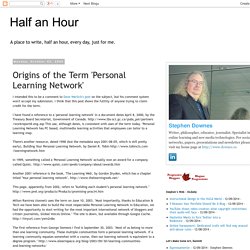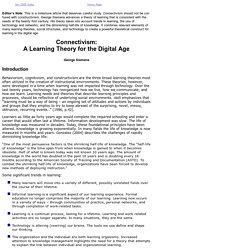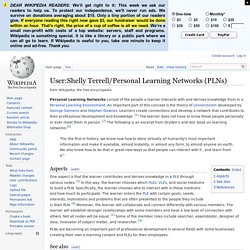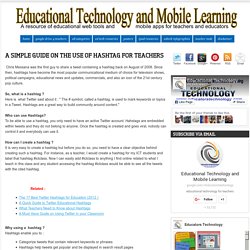

The Network is the Learning. ELTPLNs. Survival Tips for Building a PLN. For the past 4 years, I have researched the what, who, how, and why of Personal/Professional/ Passionate Learning Networks (PLNs).

We have seen the benefits of the people we choose to connect, collaborate, and problem solve with through social media. The educators, subject matter experts (SMEs), authors, and mentors we choose to derive knowledge from help us self-reflect on our methodologies and beliefs. They support us, remember our birthdays, celebrate our accomplishments, and stir within us a passion to improve the status quo. Within one year of connecting with a PLN, I jump started many projects at my school and in the past 5 years I’ve organized many free incredible professional development events with the help of my PLN. A few examples include #Edchat, the Reform Symposium Global E-Conference, The 30 Goals Challenge, and the eTextbook Teachers open online course.
My PLN helps me be a better educator and prepare my students and trainees. Why Do We Connect? Building Personal / Passionate Learning Networks for Teachers. Why Do We Connect? Weconnect [licensed for non-commercial use only] / FrontPage. Shelly Terrell: Global Netweaver, Curator, PLN Builder. When I started using social media in the classroom, I looked for and began to learn from more experienced educators.

First, I read and then tried to comment usefully on their blog posts and tweets. When I began to understand who knew what in the world of social media in education, I narrowed my focus to the most knowledgeable and adventurous among them. Shelly Terrell: Global Netweaver, Curator, Passionate Learning Network (PLN) Builder. Origins of the Term 'Personal Learning Network' I intended this to be a comment to Dave Warlick's post on the subject, but his comment system won't accept my submission.

I think that this post shows the futility of anyone trying to claim credit for the term. I have found a reference to a 'personal learning network' in a document dates April 8, 2000, by the Treasury Board Secretariat, Government of Canada. This use, although dates, is consistent with uses of the term today. "Personal Learning Network has PC based, multimedia learning activities that employees can tailor to a learning map. There's another resource, dated 1998 (but the metadata says 2001-08-05, which is still pretty early), Building Your Personal Learning Network, by Daniel R.
Jan05_01. Editor’s Note: This is a milestone article that deserves careful study.

Connectivism should not be con fused with constructivism. George Siemens advances a theory of learning that is consistent with the needs of the twenty first century. His theory takes into account trends in learning, the use of technology and networks, and the diminishing half-life of knowledge. User:Shelly Terrell/Personal Learning Networks (PLNs) "For the first in history, we know now how to store virtually all humanity's most important information and make it available, almost instantly, in almost any form, to almost anyone on earth.

We also know how to do that in great new ways so that people can interact with it , and learn from it. " One aspect is that the learner contributes and derives knowledge in a PLE through various nodes. [1] In this way, the learner chooses which PLEs, VLEs, and social mediums to build a PLN. Specifically, the learner chooses who to interact with in these mediums and how much to participate. The learner enters the PLE with certain goals, needs, interests, motivations and problems that are often presented to the people they include in their PLN. [4] Moreover, the learner will collaborate and connect differently with various members.
The learner will establish stronger relationships with some members and have a low level of connection with others. Personal Learning Networks - the what, why and how. What Does the Network Mean to You? Will Richardson - Learning in a Networked World: For Our Students & for Ourselves. Connect to the World Using Twitter. Twitter for your PLN Public by Al Rowell on Prezi. Getting Started with a PLN. Creating a Personal Learning Network. Edu-Sketch: How to Start a PLN. Certified Teachers - Community. The Ultimate Hashtag Guide for English Language Teachers. Editor’s note: This post has been updated to include the 2017 conference hashtags.

“Thanks to Twitter, the hashtag has become an important linguistic shortcut.” —Lindsay Zoladz (Pitchfork, 2014) On the web, millions of teachers worldwide connect to share support and resources. If you are in search of activities, resources, or support for a lesson, then you’ll want to know where these teachers share ideas online. Hashtags, the words you see around the web with number (#) signs in front of them, are the key to finding and sharing resources online. Below are a list of fantastic hashtags for English language teachers. According to Hashtagify, the following are some of the most used hashtags among English language teachers.
Edhashtags. "#Hashtag" with Jimmy Fallon & Justin Timberlake (Late Night with Jimmy Fallon) Educational Hash Tags. #edude#eduFollowChallenge#edugreen #eduhashtag #eduit#edumindset#eduON (Ontario)#euduoz #edupd#edupreneur#edupunk #edutech #EduThingsILike#eduvc#eduvoxers.

About - Education Chats. Teachers Teaching Teachers, on Twitter: Q. and A. on 'Edchats' Official Chat List - Education Chats. Education Chats. Weekly Twitter Chat Times - Google Sheets. EdchatHistory. New Tab. A Simple Guide on The Use of Hashtag for Teachers.
Chris Messana was the first guy to share a tweet containing a hashtag back on August of 2008.

All About Hashtags! Tagboard. TweetDeck. Everypost. Everypost. Buffer for Social Media: Twitter & More. Buffer.